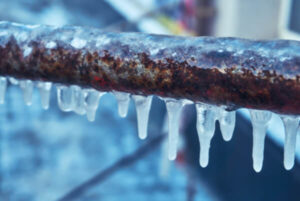Keep Your Pipes From Freezing

Generally, pipes that are exposed to frigid outdoor temperatures freeze more readily—such as hose bibs, swimming pool lines and water sprinkler lines. Pipes that run along exterior walls in your home with minimal insulation also tend to freeze more easily.
Regardless of where they are located, frozen pipes can carry significant consequences—including property damage from your pipes bursting, flooding and the potential for a disruption in water supply. With this in mind, here’s what you can do keep your pipes from freezing when temperatures drop.
-
- Insulate pipes in unheated interior areas, such as crawl spaces and attics.
- Wrap pipes in heat tape or thermostatically controlled heat cables.
- Open cabinet doors to expose pipes to warm air.
- Seal any leaks with caulk or insulation.
- Disconnect outdoor items such as hoses and faucets. Shut off these items completely using an indoor valve and allow the excess water to drain out.
- Trickle a little water out of your faucets periodically to keep water moving within the pipes.
- Keep your garage door closed if there is a water supply in there.
- Keep your thermostat set at the same temperature during the day and night.
- Do not set your thermostat lower than 55 degrees Fahrenheit when going on vacation. Ask someone to periodically check the temperature in your home while you are away.
Pipes That Freeze Most Frequently
So you know what can happen in a worst-case scenario… and it doesn’t even need to be winter for you to suffer from damages!
Water expands as it freezes and puts significant pressure on the metal or plastic pipes that hold it. Pipes that are exposed to extreme cold, including those outdoors and along the exterior walls of your home, can burst when water expands and may need extra protection during winter months.
It’s important you know which types of pipes freeze most often so you can prepare accordingly, year-round. They are:
- Pipes exposed to severe cold, like outdoor hose bibs, hookups and faucets, swimming pool supply lines, and water/lawn sprinkler lines.
- Water supply pipes in unheated interior areas like basements and crawl spaces, attics, garages, or kitchen cabinets.
- Pipes that run against exterior walls that have little or no insulation.
How to Respond to Frozen Pipes
If you turn on a faucet and no water or only a trickle comes out, your pipes may be frozen. Turn off the main water valve and keep the faucet on. Apply heat to the pipe by using an electric heating pad, hair dryer or portable space heater, or by wrapping the pipe in towels soaked in hot water. You should apply heat until you regain water pressure. If this does not solve the problem, contact a licensed plumber to inspect your pipes.
Last, but not least, we recommend having the right insurance coverage in place in case the unforeseen happens. If you have questions about your coverage, or would like to add a policy before it’s too late, contact us today.
© 2008, 2013, 2016, 2021 Zywave, Inc. All rights reserved.